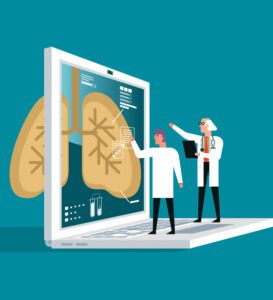 Current and former heavy smokers may have heard some mention of Low Dose Computed Tomography in the news or by their doctor. People have questions about LDCT and how it may apply to them. Here are some of the most common queries, along with informed answers and experienced responses from our Board-certified, subspecialized radiologists.
Current and former heavy smokers may have heard some mention of Low Dose Computed Tomography in the news or by their doctor. People have questions about LDCT and how it may apply to them. Here are some of the most common queries, along with informed answers and experienced responses from our Board-certified, subspecialized radiologists.
What is LDCT?
Low Dose Computed Tomography is a highly advanced screening procedure recommended annually for patients at high risk of developing lung cancer. LDCT is able to spot lung cancer in its earliest stages, and captures tiny details significantly better than standard chest x-ray, for a greater chance of an accurate and early diagnosis. As the “low dose” part of its name suggests, LDCT delivers a low dose of radiation considered safe by the FDA, ACR and other governing bodies. “LDCT screening enables your radiologist to diagnose lung cancer while it is small and localized, when treatment is most effective,” says radiologist Brian Cartwright, MD. “Discovering lung cancer early, before it has a chance to spread, greatly increases the chance of successful treatment and survival.”
Who is a Candidate for LDCT Screening?
While smoking isn’t the only cause of lung cancer in the US, cigarette smoking accounts for 80-90% of cases, with cigar and pipe smoking increasing the risk. LDCT screening is an option for people aged 55-80 who are current smokers or former smokers who quit within the past 15 years with a 30 pack-year pack history, which is measured by the number of packs smoked a day multiplied by the number of years spent smoking. 1 pack x 30 years or 2 packs x 15 years equals 30 pack years. Once a person has reached 30 pack years, they are considered at high risk of developing lung cancer until they have stopped smoking for 15 years or more.
What if I Have No Symptoms?
A lot of people assume lung cancer will produce warning signs, like chronic cough, wheezing, shortness of breath or hemoptysis (coughing up blood).
In its early stages, lung cancer typically produces no symptoms at all, allowing it to spread throughout and outside the lungs, when it becomes very difficult – even impossible – to treat. “Some of my patients who smoke or used to smoke tell me they feel fine, and take that as evidence that their lungs are healthy,” says Dr. Cartwright. “Sadly, once people develop certain symptoms, it can signify that the cancer has spread to a point where effective treatment is no longer an option.”
How Serious is Lung Cancer?
Obviously, all cancers can be serious, but lung cancer is more dangerous than many people realize. 1 in 15 people in the US will get a lung cancer diagnosis in their lifetime, with fewer than 1 in 7 people getting the disease diagnosed in its earliest, most treatable stage. Because it is too often undiagnosed in time, lung cancer is the number one cause of cancer death in the US, accounting for 24% of all cancer deaths. “Lung cancer kills nearly twice as many women as does breast cancer,” says Dr. Cartwright. “And it kills more than three times as many men than prostate cancer does. These statistics are particularly tragic because, when caught early, lung cancer can be highly survivable, so screening is really valuable for high risk individuals.”
Why LDCT Over Chest X-ray?
For many years, chest x-ray was used to help diagnose lung cancer, with good success. But advances in technology have produced LDCT, a superior screening modality. Early detection through LDCT can reduce lung cancer mortality by as much as 20% among high-risk patients compared to chest x-ray. That means 1 out of 5 more lung cancer patients will get an early and accurate diagnosis and appropriate treatment using LDCT.
Is LDCT Painful?
Not at all. You simply lie comfortably on a table while images of your lungs are captured. LDCT does not require the use of contrast material, so no injections are needed. The scan demands no change in eating and drinking habits and takes only a few quick minutes.
How Do I Schedule an LDCT Screen?
The first step is to talk to your doctor or referring clinician, who will review your smoking history, health status and other factors to determine your eligibility for annual LDCT screening. Eligible patients will have their screenings covered by Medicare.
If you are 55 or older and are or were a heavy smoker, don’t wait. Contact your doctor or clinician and ask if LDCT screening might be a potentially life-saving option for you. A few minutes each year could help ensure that you have many more years ahead.
Radiology Associates of Ocala
www.RAOcala.com
352-671-4300
 Central Florida Health and Wellness Magazine Health and Wellness Articles of the Villages
Central Florida Health and Wellness Magazine Health and Wellness Articles of the Villages



